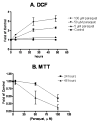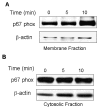Cytotoxicity of paraquat in microglial cells: Involvement of PKCdelta- and ERK1/2-dependent NADPH oxidase
- PMID: 17662968
- PMCID: PMC2084263
- DOI: 10.1016/j.brainres.2007.06.046
Cytotoxicity of paraquat in microglial cells: Involvement of PKCdelta- and ERK1/2-dependent NADPH oxidase
Abstract
Excess production of reactive oxygen species (ROS) is an important mechanism underlying the pathogenesis of a number of neurodegenerative diseases including Parkinson's disease (PD) which is characterized by a progressive loss of dopaminergic neurons in the substantia nigra. Exposure to paraquat, an herbicide with structure similar to the dopaminergic neurotoxin, 1-methyl-4-phenylpyridinium (MPP+), has been shown to produce PD-like symptoms. Despite previous focus on the dopaminergic neurons and signaling pathways involved in their cell death, recent studies have implicated microglial cells as a major producer of ROS for damaging neighboring neurons. In this study, we examined the source of ROS and the underlying signaling pathway for paraquat-induced cytotoxicity to BV-2 microglial cells. Paraquat-induced ROS production (including superoxide anions) in BV-2 cells was accompanied by translocation of the p67phox cytosolic subunit of NADPH oxidase to the membrane. Paraquat-induced ROS production was inhibited by NADPH oxidase inhibitors, apocynin and diphenylene iodonium (DPI), but not the xanthine/xanthine oxidase inhibitor, allopurinol. Apocynin and DPI also rescued cells from paraquat-induced toxicity. The inhibitors for protein kinase C delta (PKCdelta) or extracellular signal-regulated kinases (ERK1/2) could partially attenuate paraquat-induced ROS production and cell death. Rottlerin, a selective PKCdelta inhibitor, also inhibited paraquat-induced translocation of p67phox. Taken together, this study demonstrates the involvement of ROS from NADPH oxidase in mediating paraquat cytotoxicity in BV-2 microglial cells and this process is mediated through PKCdelta- and ERK-dependent pathways.
Figures








Similar articles
-
Microglial activation as a priming event leading to paraquat-induced dopaminergic cell degeneration.Neurobiol Dis. 2007 Feb;25(2):392-400. doi: 10.1016/j.nbd.2006.10.008. Epub 2006 Dec 12. Neurobiol Dis. 2007. PMID: 17166727 Free PMC article.
-
Paraquat and maneb co-exposure induces noradrenergic locus coeruleus neurodegeneration through NADPH oxidase-mediated microglial activation.Toxicology. 2017 Apr 1;380:1-10. doi: 10.1016/j.tox.2017.02.009. Epub 2017 Feb 13. Toxicology. 2017. PMID: 28202386
-
Pharmacological inhibition of neuronal NADPH oxidase protects against 1-methyl-4-phenylpyridinium (MPP+)-induced oxidative stress and apoptosis in mesencephalic dopaminergic neuronal cells.Neurotoxicology. 2007 Sep;28(5):988-97. doi: 10.1016/j.neuro.2007.08.008. Epub 2007 Aug 25. Neurotoxicology. 2007. PMID: 17904225 Free PMC article.
-
Novel cell death signaling pathways in neurotoxicity models of dopaminergic degeneration: relevance to oxidative stress and neuroinflammation in Parkinson's disease.Neurotoxicology. 2010 Sep;31(5):555-61. doi: 10.1016/j.neuro.2009.12.003. Epub 2009 Dec 11. Neurotoxicology. 2010. PMID: 20005250 Free PMC article. Review.
-
Oxidative and inflammatory pathways in Parkinson's disease.Neurochem Res. 2009 Jan;34(1):55-65. doi: 10.1007/s11064-008-9656-2. Epub 2008 Mar 25. Neurochem Res. 2009. PMID: 18363100 Review.
Cited by
-
Rodent models and contemporary molecular techniques: notable feats yet incomplete explanations of Parkinson's disease pathogenesis.Mol Neurobiol. 2012 Oct;46(2):495-512. doi: 10.1007/s12035-012-8291-8. Epub 2012 Jun 27. Mol Neurobiol. 2012. PMID: 22736079 Review.
-
Behavioral Phenotyping and Pathological Indicators of Parkinson's Disease in C. elegans Models.Front Genet. 2017 Jun 13;8:77. doi: 10.3389/fgene.2017.00077. eCollection 2017. Front Genet. 2017. PMID: 28659967 Free PMC article. Review.
-
Resveratrol as a therapeutic agent for neurodegenerative diseases.Mol Neurobiol. 2010 Jun;41(2-3):375-83. doi: 10.1007/s12035-010-8111-y. Epub 2010 Mar 21. Mol Neurobiol. 2010. PMID: 20306310 Free PMC article. Review.
-
Protective effect of 4,4'-diaminodiphenylsulfone against paraquat-induced mouse lung injury.Exp Mol Med. 2011 Sep 30;43(9):525-37. doi: 10.3858/emm.2011.43.9.060. Exp Mol Med. 2011. PMID: 21765237 Free PMC article.
-
A role for Mfb1p in region-specific anchorage of high-functioning mitochondria and lifespan in Saccharomyces cerevisiae.Nat Commun. 2016 Feb 3;7:10595. doi: 10.1038/ncomms10595. Nat Commun. 2016. PMID: 26839174 Free PMC article.
References
-
- Andresen JJ, Faraci FM, Heistad DD. Vasomotor responses in MnSOD-deficient mice. American Journal of Physiology - Heart & Circulatory Physiology. 2004;287(3):H1141–8. - PubMed
-
- Barcia C, Bahillo AS, Fernandez-Villalba E, Bautista V, Poza MP, Fernandez-Barreiro A, Hirsch EC, Herrero M-T. Evidence of the active microglia in substantia nigra pars compacta of Parkinsonian monkeys 1 year after MPTP exposure. GLIA. 2004;46:402–9. - PubMed
-
- Beal MF. Mitochondria, oxidative damage, and inflammation in Parkinson’s disease. Annals of New York Academy of Sciences. 2003;991:120–31. - PubMed
-
- Bey EA, Xu B, Bhattacharjee A, Oldfield CM, Zhao X, Li Q, Subbulakshmi V, Feldman GM, Wientjes FB, Cathcart MK. Protein kinase C delta is required for p47phox phosphorylation and translocation in activated human monocytes. Journal of Immunology. 2004;173:5730–8. - PubMed
MeSH terms
Substances
Grants and funding
LinkOut - more resources
Full Text Sources
Other Literature Sources
Miscellaneous

